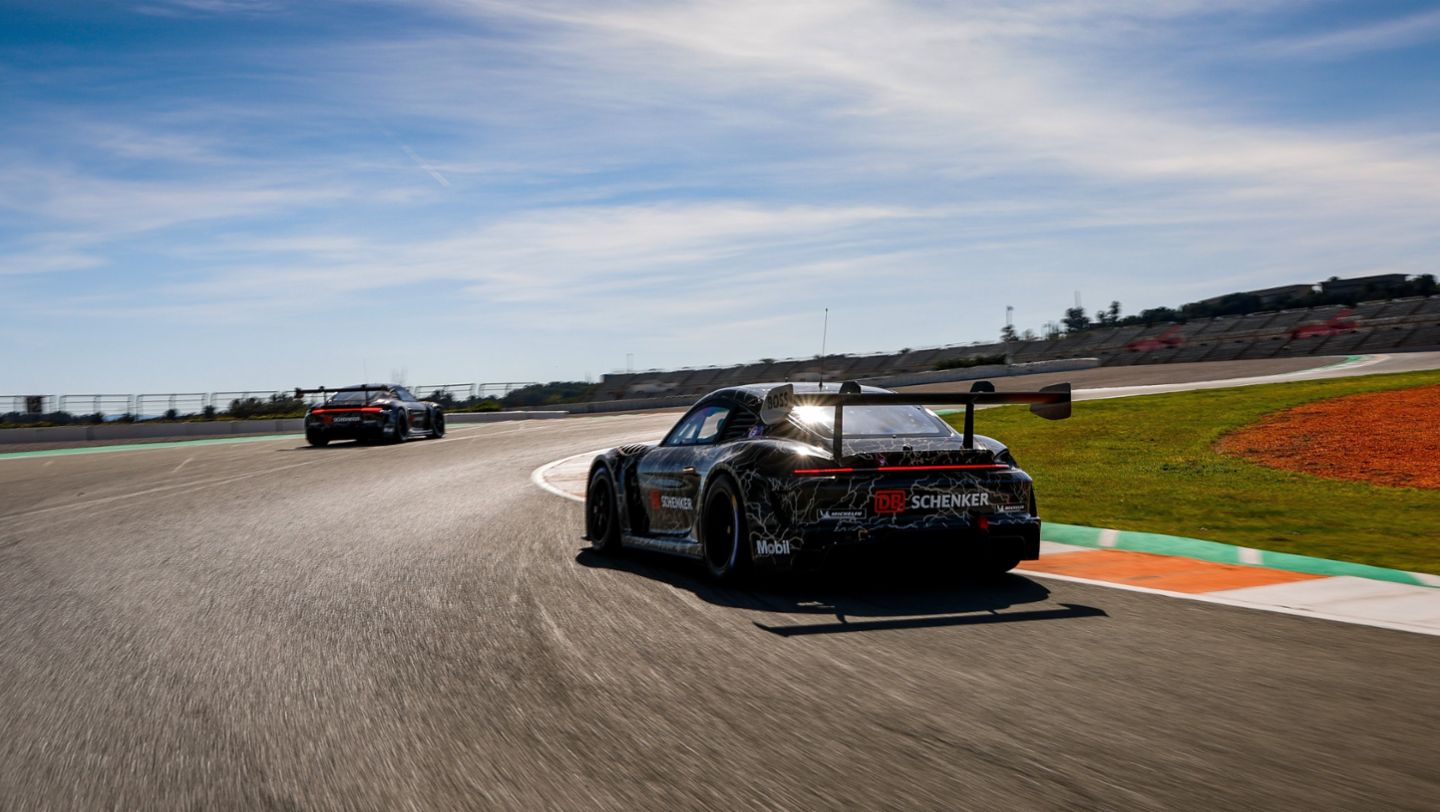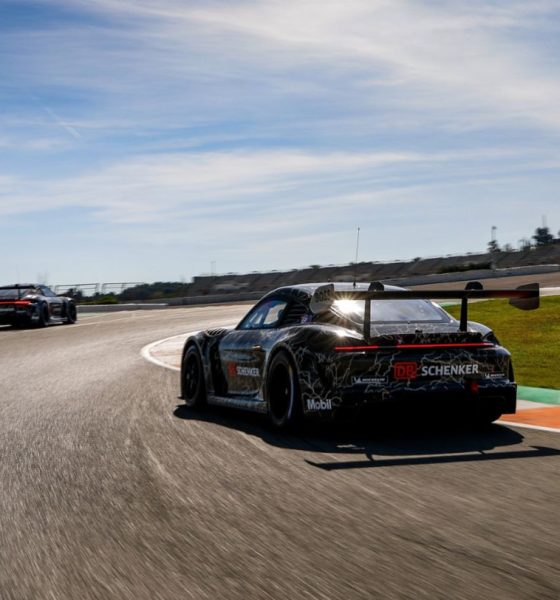

News
Porsche flexes e-Motorsport prowess with GT4 ‘ePerfomance’
Porsche has shown off its electric GT4 ePerformance racecar at an ice track race in Sweden.
As a leader in vehicles that put a smile on your face, Porsche is under distinct pressure to bring that same excitement and joy to the EV transition, and it’s clear that it intends to do just that. First shown at the Goodwood Festival of Speed last year, the Porsche GT4 ePerformance has made another debut, this time at an ice track race in Northern Sweden.
At the Race of Champions event in Northern Sweden, Porsche got the opportunity to show off its GT4 ePerformance project, a car that is set to define the future of electric motorsports.
The Porsche GT4 ePerformance is a serious racecar, no question about it. Fitted with carbon fiber body panels, the tried and true aerodynamics of Porsche’s fastest racecars, and a stripped interior, it is the real deal and has the performance to back it up.
The full specifications of the vehicle are not yet known, but a surprising amount of information has been revealed over the past year. First of all, the ePerformance is designed to last a minimum of 30 minutes on the racetrack, what Porsche says is the equivalent of 1 Porsche Carera Cup race, allowing drivers to push the car to its absolute limit without the worry of a dead battery mid-race.
Second, the drivetrain, likely using a dual or tri-motor system, produces similarly insane power as its gas counterparts. It packs 603 horsepower for its 30-minute race setting or up to 1088 horsepower peak. But perhaps even more surprising is the car’s incredibly quick charging. According to Porsche engineers, the vehicle can charge from 5 to 8 percent in as little as 15 minutes thanks to its 900-volt architecture.
View this post on Instagram
While Porsche did not provide a statement on the vehicle or today’s race for that matter, Porsche’s Project Manager of Sales Oliver Schwab told Teslarati:
“The 718 Cayman GT4 ePerformance blazes a trail to Porsche customer racing with electrically-powered racing cars. As a first step, we will unveil this concept to our global partners. With drivers, teams, organizers, authorities, and other interested parties, we’re also gathering ideas for Porsche racing formats in the future.”
To show off this incredible power, Porsche chose the ideal venue. For those unfamiliar, the “Race of Champions” (ROC) is a series of races that take place around the globe, forcing the best drivers on the planet to face off; on the same track, same car, and same day. This event includes participants such as four-time F1 Champion Sebastian Vettel, six-time American rally champion Travis Pastrana, ten-time F1 Champion Valtteri Botas, nine-time 24 Hour of LeMans winner Tom Kristenson, need I say more.
But merely coming to the event was not nearly enough for the thrill junkies from Stuttgart. The GT4 ePerformance was fitted with spiked tires and one of the largest wings I have ever seen mounted on a Porsche vehicle, allowing the car to rip and jump through the icy course with ease.
If this is the future of motorsport, I want it.
And thankfully, I (and many others) won’t have to wait much longer. While unconfirmed by Porsche, the high-performance electric 911 could very well make its production debut following the introduction of the company’s newest EV platform, PPE. And with the numerous benefits to handling, power efficiency, and weight reduction, the car could be a rocket ship.
According to a Porsche press release from late last year, the GT4 ePerformance will be headed to North America for the first half of this year, making a tour throughout the continent to show potential customers the incredible future of electric Porsche racing, and will ultimately end up in Asia after completing its grand tour.
Porsche has shown in today’s video that motorsports are here to stay and may flourish with the upcoming EV transition. With such a noble goal, who could oppose them? Who knows, with the dedication to its electric performance vehicle offerings, it might just be enough to drag a certain American EV maker to the same market. And if this product is a showing of Porsche’s future products, such a competitor might finally have something to worry about.
What do you think of the article? Do you have any comments, questions, or concerns? Shoot me an email at william@teslarati.com. You can also reach me on Twitter @WilliamWritin. If you have news tips, email us at tips@teslarati.com!

News
Tesla (TSLA) receives “Buy” rating and $551 PT from Canaccord Genuity
He also maintained a “Buy” rating for TSLA stock over the company’s improving long-term outlook, which is driven by autonomy and robotics.

Canaccord Genuity analyst George Gianarikas raised his Tesla (NASDAQ:TSLA) price target from $482 to $551. He also maintained a “Buy” rating for TSLA stock over the company’s improving long-term outlook, which is driven by autonomy and robotics.
The analyst’s updated note
Gianarikas lowered his 4Q25 delivery estimates but pointed to several positive factors in the Tesla story. He noted that EV adoption in emerging markets is gaining pace, and progress in FSD and the Robotaxi rollout in 2026 represent major upside drivers. Further progress in the Optimus program next year could also add more momentum for the electric vehicle maker.
“Overall, yes, 4Q25 delivery expectations are being revised lower. However, the reset in the US EV market is laying the groundwork for a more durable and attractive long-term demand environment.
“At the same time, EV penetration in emerging markets is accelerating, reinforcing Tesla’s potential multi‑year growth runway beyond the US. Global progress in FSD and the anticipated rollout of a larger robotaxi fleet in 2026 are increasingly important components of the Tesla equity story and could provide sentiment tailwinds,” the analyst wrote.
Tesla’s busy 2026
The upcoming year would be a busy one for Tesla, considering the company’s plans and targets. The autonomous two-seat Cybercab has been confirmed to start production sometime in Q2 2026, as per Elon Musk during the 2025 Annual Shareholder Meeting.
Apart from this, Tesla is also expected to unveil the next-generation Roadster on April 1, 2026. Tesla is also expected to start high-volume production of the Tesla Semi in Nevada next year.
Apart from vehicle launches, Tesla has expressed its intentions to significantly ramp the rollout of FSD to several regions worldwide, such as Europe. Plans are also underway to launch more Robotaxi networks in several more key areas across the United States.
News
Waymo sues Santa Monica over order to halt overnight charging sessions
In its complaint, Waymo argued that its self-driving cars’ operations do not constitute a public nuisance, and compliance with the city’s order would cause the company irreparable harm.

Waymo has filed a lawsuit against the City of Santa Monica in Los Angeles County Superior Court, seeking to block an order that requires the company to cease overnight charging at two facilities.
In its complaint, Waymo argued that its self-driving cars’ operations do not constitute a public nuisance, and compliance with the city’s order would cause the company irreparable harm.
Nuisance claims
As noted in a report from the Los Angeles Times, Waymo’s two charging sites at Euclid Street and Broadway have operated for about a year, supporting the company’s growing fleet with round-the-clock activity. Unfortunately, this has also resulted in residents in the area reportedly being unable to sleep due to incessant beeping from self-driving taxis that are moving in and out of the charging stations around the clock.
Frustrated residents have protested against the Waymos by blocking the vehicles’ paths, placing cones, and “stacking” cars to create backups. This has also resulted in multiple calls to the police.
Last month, the city issued an order to Waymo and its charging partner, Voltera, to cease overnight operations at the charging locations, stating that the self-driving vehicles’ activities at night were a public nuisance. A December 15 meeting yielded no agreement on mitigations like software rerouting. Waymo proposed changes, but the city reportedly insisted that nothing would satisfy the irate residents.
“We are disappointed that the City has chosen an adversarial path over a collaborative one. The City’s position has been to insist that no actions taken or proposed by Waymo would satisfy the complaining neighbors and therefore must be deemed insufficient,” a Waymo spokesperson stated.
Waymo pushes back
In its legal complaint, Waymo stated that its “activities at the Broadway Facilities do not constitute a public nuisance.” The company also noted that it “faces imminent and irreparable harm to its operations, employees, and customers” from the city’s order. The suit also stated that the city was fully aware that the Voltera charging sites would be operating around the clock to support Waymo’s self-driving taxis.
The company highlighted over one million trips in Santa Monica since launch, with more than 50,000 rides starting or ending there in November alone. Waymo also criticized the city for adopting a contentious strategy against businesses.
“The City of Santa Monica’s recent actions are inconsistent with its stated goal of attracting investment. At a time when the City faces a serious fiscal crisis, officials are choosing to obstruct properly permitted investment rather than fostering a ‘ready for business’ environment,” Waymo stated.
News
Tesla FSD v14.2.2 is getting rave reviews from drivers
So far, early testers have reported buttery-smooth drives with confident performance, even at night or on twisty roads.

Tesla Full Self-Driving (Supervised) v14.2.2 is receiving positive reviews from owners, with several drivers praising the build’s lack of hesitation during lane changes and its smoother decision-making, among others.
The update, which started rolling out on Monday, also adds features like dynamic arrival pin adjustment. So far, early testers have reported buttery-smooth drives with confident performance, even at night or on twisty roads.
Owners highlight major improvements
Longtime Tesla owner and FSD user @BLKMDL3 shared a detailed 10-hour impression of FSD v14.2.2, noting that the system exhibited “zero lane change hesitation” and “extremely refined” lane choices. He praised Mad Max mode’s performance, stellar parking in locations including ticket dispensers, and impressive canyon runs even in dark conditions.
Fellow FSD user Dan Burkland reported an hour of FSD v14.2.2’s nighttime driving with “zero hesitations” and “buttery smooth” confidence reminiscent of Robotaxi rides in areas such as Austin, Texas. Veteran FSD user Whole Mars Catalog also demonstrated voice navigation via Grok, while Tesla owner Devin Olsen completed a nearly two-hour drive with FSD v14.2.2 in heavy traffic and rain with strong performance.
Closer to unsupervised
FSD has been receiving rave reviews, even from Tesla’s competitors. Xpeng CEO He Xiaopeng, for one, offered fresh praise for FSD v14.2 after visiting Silicon Valley. Following extended test drives of Tesla vehicles running the latest FSD software, He stated that the system has made major strides, reinforcing his view that Tesla’s approach to autonomy is indeed the proper path towards autonomy.
According to He, Tesla’s FSD has evolved from a smooth Level 2 advanced driver assistance system into what he described as a “near-Level 4” experience in terms of capabilities. While acknowledging that areas of improvement are still present, the Xpeng CEO stated that FSD’s current iteration significantly surpasses last year’s capabilities. He also reiterated his belief that Tesla’s strategy of using the same autonomous software and hardware architecture across private vehicles and robotaxis is the right long-term approach, as it would allow users to bypass intermediate autonomy stages and move closer to Level 4 functionality.








